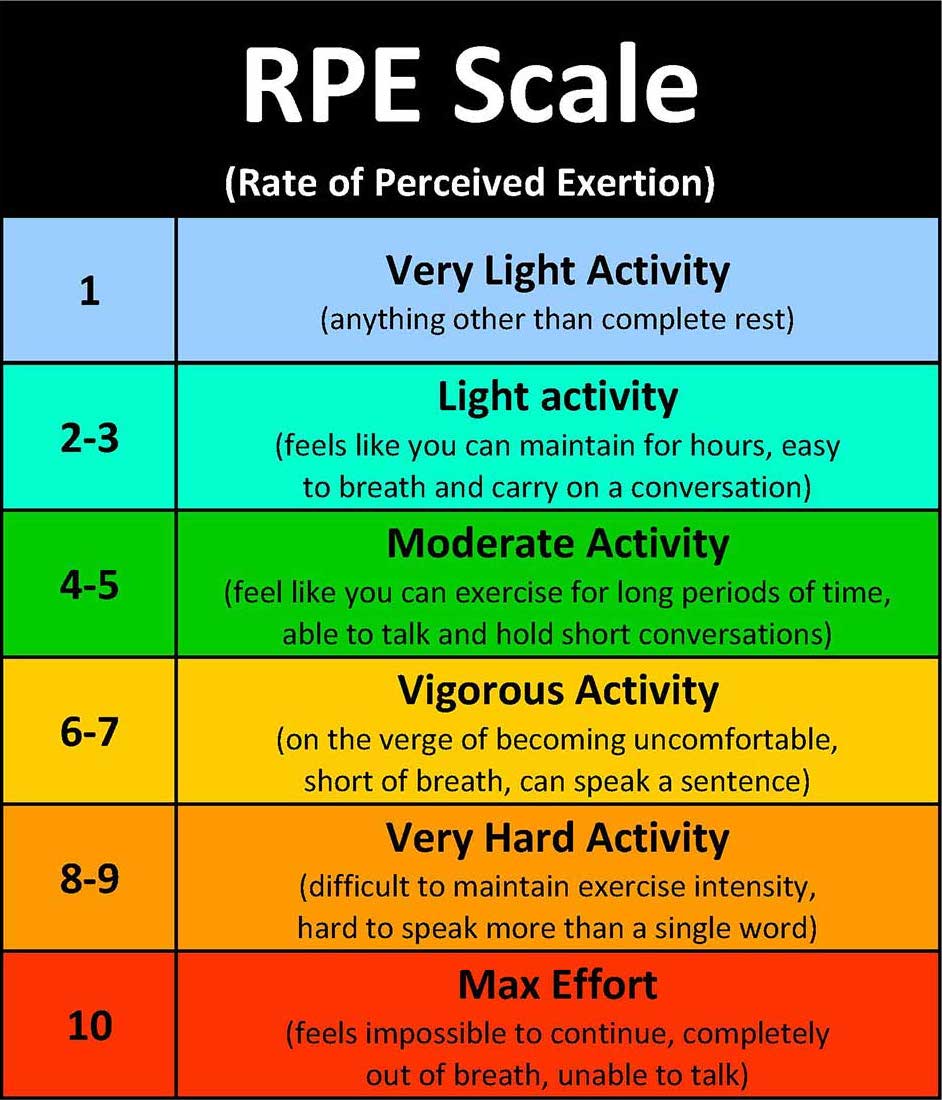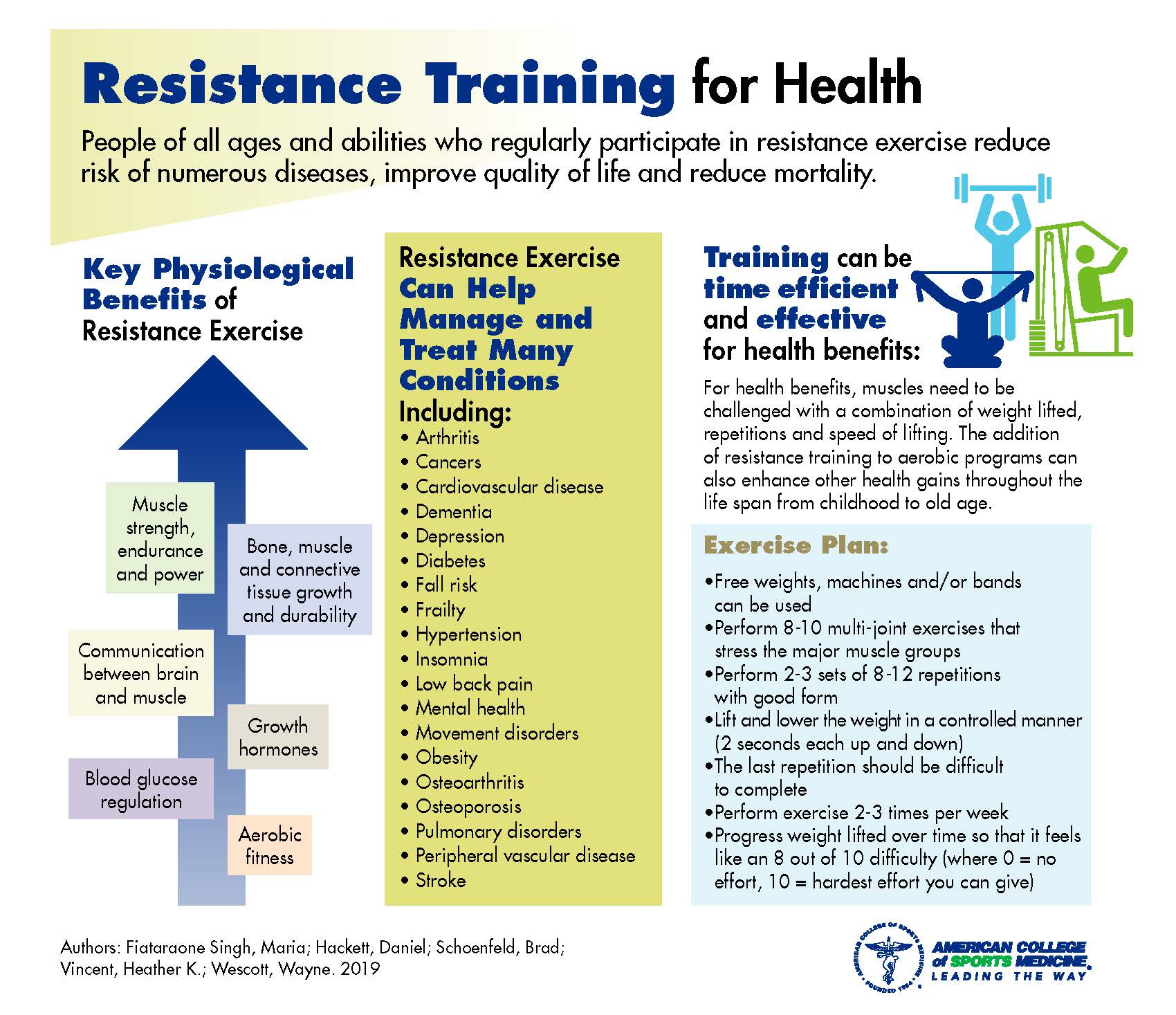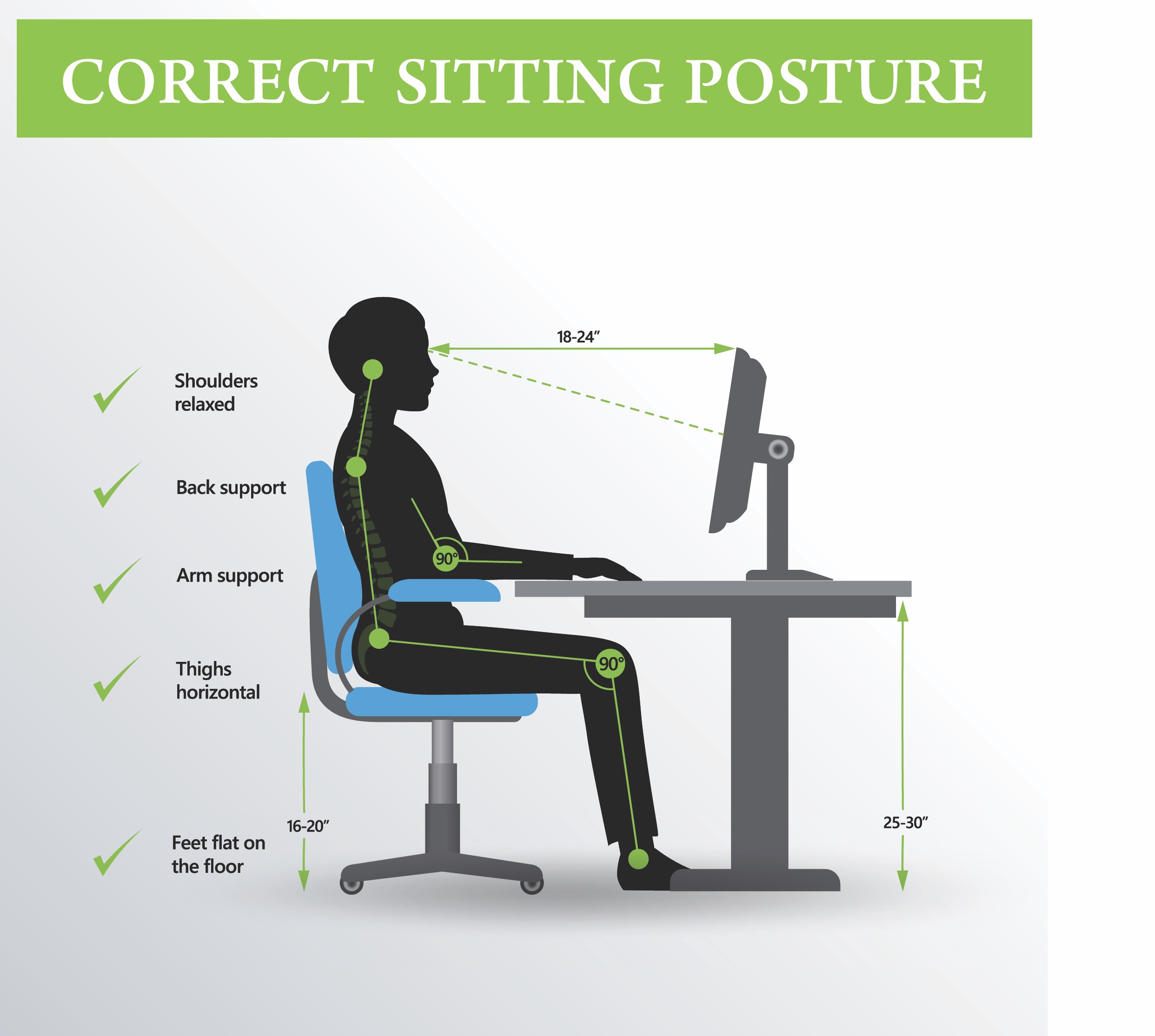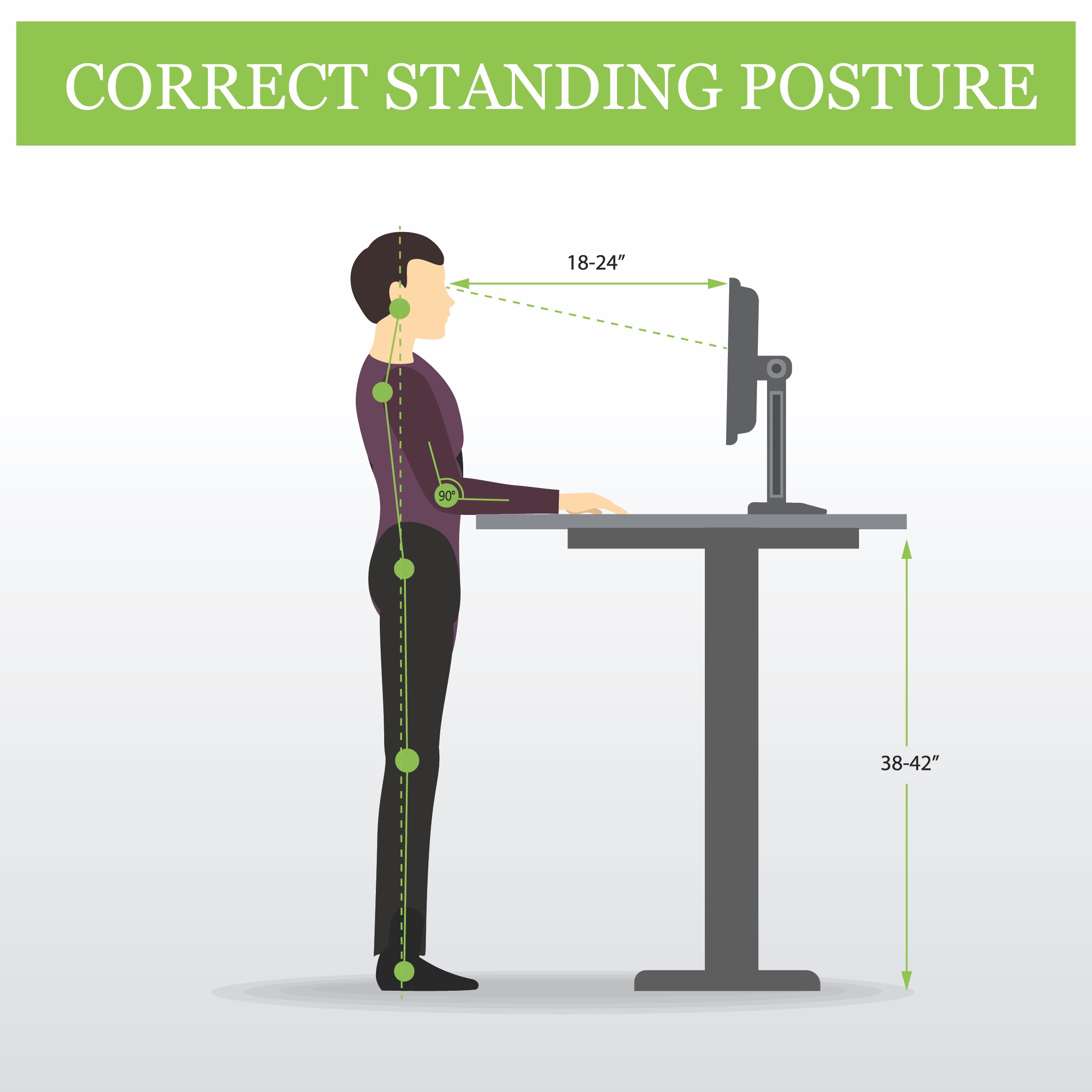OUR RECOMMENDATIONS FOR.......
Gaining and maintaining a balanced body through exercise and self care.
MOVEMENT & EXERCISE
For both strength and endurance exercise we recommend using your perceived exertion, rather than your heart rate, to assess the intensity level of the workout.What Is Perceived Exertion and Rating of Perceived Exertion (RPE) scale?
Perceived exertion is how hard you feel your body is working. It is based on the physical sensations a person experiences during physical activity, including increased heart rate, increased respiration or breathing rate, increased sweating, and muscle fatigue.
Rating of perceived exertion (RPE) scale is a widely used and reliable indicator to monitor and guide exercise intensity. The scale allows individuals to subjectively rate their level of exertion during exercise or exercise testing (American College of Sports Medicine, 2010).What makes the RPE scale particularly effective for monitoring exercise intensity is that it’s a relative scale applied specifically to you. The RPE scale allows for daily changes in your training. You can push harder than usual on days where you feel great, and back off on days where you feel sluggish.The RPE scale runs from 0 – 10. The numbers below relate to phrases used to rate how easy or difficult you find an activity.How to Use the Rating of Perceived Exertion Scale
After warming up at a light level of exertion, begin your workout. After a few minutes, assess your RPE from the scale. If you are still at an RPE under 4, pick up your pace or add resistance to increase your intensity.- Working at anything between 4 to 7 on the 0-10 scale will count as aerobic exercise.
- Anything above 6-7 on the 0-10 scale will be anaerobic exercise.

STRENGTH/RESISTANCE TRAINING
The American Heart Association recommends strength training at least twice per week.
Strengthening your muscles gives you the ability to perform everyday activities and helps protect your body from injury. Stronger muscles also lead to a boost in your metabolic rate, which means you’ll burn more calories even when your body is at rest.
Strength training can be done at home or in the gym.
Getting started
- If you have a chronic condition, or if you're older than age 40 and you haven't been active recently, check with your doctor before beginning a strength training or aerobic fitness program.
- Before beginning strength training, consider warming up with brisk walking or another aerobic activity for five or 10 minutes. Cold muscles are more prone to injury than are warm muscles.
- Choose a weight or resistance level heavy enough to tire your muscles after about 2 sets of 10 to 12 repetitions
- To give your muscles time to recover, rest one full day between exercising each specific muscle group.
- Also be careful to listen to your body. If a strength training exercise causes pain, stop the exercise. Consider trying a lower weight or trying it again in a few days.
- It's important to use proper technique in strength training to avoid injuries.
- Remember to breathe as you strength train.

ENDURANCE/AEROBIC EXERCISE
These recommendations are based on the  Physical Activity Guidelines for Americans, 2nd edition, published by the U.S. Department of Health and Human Services, Office of Disease Prevention and Health Promotion. They recommend how much physical activity we need to be healthy. The guidelines are based on current scientific evidence supporting the connections between physical activity, overall health and well-being, disease prevention and quality of life.
Physical Activity Guidelines for Americans, 2nd edition, published by the U.S. Department of Health and Human Services, Office of Disease Prevention and Health Promotion. They recommend how much physical activity we need to be healthy. The guidelines are based on current scientific evidence supporting the connections between physical activity, overall health and well-being, disease prevention and quality of life.
Recommendations for Adults
Get at least 150 minutes per week of moderate-intensity aerobic activity or 75 minutes per week of vigorous aerobic activity, or a combination of both, preferably spread throughout the week.
Add moderate- to high-intensity muscle-strengthening activity (such as resistance or weights) on at least 2 days per week.
Spend less time sitting. Even light-intensity activity can offset some of the risks of being sedentary.
Gain even more benefits by being active at least 300 minutes (5 hours) per week.
Increase amount and intensity gradually over time.
Recommendations for Kids
Children 3-5 years old should be physically active and have plenty of opportunities to move throughout the day.
Kids 6-17 years old should get at least 60 minutes per day of moderate- to vigorous-intensity physical activity, mostly aerobic.
Include vigorous-intensity activity on at least 3 days per week.
Include muscle- and bone-strengthening (weight-bearing) activities on at least 3 days per week.
Increase amount and intensity gradually over time.
FLEXIBILITY
When should I stretch?
The best time to do flexibility exercises is when your muscles are already warm so they can stretch farther without tightness or pain. If you’re doing only stretching exercises, warm up with a few minutes of easy walking first to warm up your muscles. If you’re doing endurance or strength exercises, stretch after, not before.How much do I need?
Stretch slowly and smoothly into the desired position, as far as is comfortable for you without pain. Do what is comfortable for you. If you’re not used to stretching, hold the stretch for about 10 seconds. The more often you stretch, the easier it will become. Eventually, you will be able to hold each stretch for 30 to 60 seconds comfortably.Tips for safe stretching:
BALANCE AND COORDINATION
Having good balance is important for many activities we do every day, such as walking and going up and down the stairs. Exercises that improve balance can help prevent falls, a common problem in older adults and stroke patients. They can also benefit those who are obese since weight is not always carried or distributed evenly throughout the body. A loss of balance can occur when standing or moving suddenly. Often we are not fully aware that we may have weak balance until we try balance exercises.
How much do I need?
Balance exercises can be done every day or as many days as you like and as often as you like. Preferably, older adults at risk of falls should do balance training 3 or more days a week and do standardized exercises from a program demonstrated to reduce falls. If you think you might be at risk of falling, talk to your doctor.
Exercise forms that require good balance, such as Tai chi, dance and Yoga also may help prevent falls. These forms of exercise require balance in different planes of motion of the body and require more coordination. The increased difficulty of these exercises will enhance balance and may decrease fall risk.
Try these balance exercises:
- See how long you can stand on one foot. A good goal is to be able to stand on each foot for thirty seconds without touching down.
- If you find standing on one foot very challenging at first, try this progression to improve your balance:
- Hold on to a wall or sturdy chair with both hands to support yourself.
- Next, hold on with only one hand.
- Then support yourself with only one finger.
- When you are steady on your feet, try balancing with no support at all.
- Stand with one foot directly in front of the other, heel to toe. This is called a tandem stance. Your goal is to be able to perform this exercise for thirty seconds without touching down. Try it with the right foot behind and then switch to having the left foot behind. If this is too difficult then widen your stance a little bit, until you find the position where can balance for thirty seconds. Challenge yourself to eventually narrow the stance as much as possible.
- Walk normally in as straight a line as you can as though walking on a tightrope or a very narrow plank.
SLEEP
We recommend the work of neuroscientist and sleep researcher, Matthew Walker.
Walker is a professor of neuroscience and psychology and the director of the Center for Human Sleep Science at the University of California, Berkeley.
He wrote Why We Sleep: The New Science of Sleep and Dreams.
He also has an excellent Ted Talk about sleep.
NUTRITION
Diet and nutrition play an important part in our overall health and in the body's ability to heal from trauma.
We will discuss these aspects of your health with you during your treatment and refer you to a nutritional expert as needed.
ERGONOMICS OF THE WORK STATION: The US Department of Labor OSHA site
 Computer Workstation eTool is an excellent reference for proper sitting ergonomics,
Computer Workstation eTool is an excellent reference for proper sitting ergonomics,
except for the pictures that they use to demonstrate proper posture.
Use the pictures below as your ergonomic computer station sitting and standing examples.

It is best to try to stand and move, or move (if already standing) about every hour. These hourly exercises do not have to be for an extended period of time.
There is also a place for rest during the day....for getting our bodies away from the forces of gravity. Lying down in a comfortable position during the day to meditate or read. Taking a short nap. Taking a "siesta".
And it is not just time spent sitting at work, it is overall sitting time, 24/7, that needs to be addressed.
Here is the original article that prompted so many media sites to exaggerate (to a certain extent) the dangers of sitting:
 Prolonged Leisure Time Spent Sitting In Relation To Cause-Specific Mortality In A Large US Cohort
Prolonged Leisure Time Spent Sitting In Relation To Cause-Specific Mortality In A Large US Cohort
 The following two You Tube videos have good information about posture and ergonomics put together in a very viewer friendly package.
The following two You Tube videos have good information about posture and ergonomics put together in a very viewer friendly package.
Our vision is to seed ‘healthy notions of self through neuroscience knowledge’ worldwide. There are currently five critical conceptual change issues which underpin this:
- Injury or disease does not mean that you feel pain
- The nervous system moves and stretches as we move
- Pain, stress and performance are outputs of the brain
- Knowledge and movement are the greatest pain and stress liberators
- Nervous system plasticity gives new hope and technique
 Painful-Yarns-Lorimer-Moseley
Painful-Yarns-Lorimer-MoseleyDANIELLE ROSENMAN, MD
 Medical Counseling includes information about her group counseling;
Medical Counseling includes information about her group counseling; 3030 Ashby Ave., Suite 117, Berkeley, CA 94705
Danielle primarily uses neuroplasticity tools developed by Michael Moskowitz, MD.
Dr Moskowitz's website is somewhat out of date, but still has some good resources;  neuroplastix.com
neuroplastix.com
LAURIE VOLLEN, MD
Laurie Vollen is a local physician, located in Berkeley, who provides "comprehensive medical services for patients seeking to address their medical needs through the safe and effective use of medical marijuana."
You can find more information about Dr. Vollen at her website  Naturally Healing MD
Naturally Healing MD
Medical marijuana has many other uses besides pain management, but it is probably the primary medical use for our patients.
Medical marijuana should always be used in consultation with your primary care physician.
It is important to seek the advice of a knowledgeable practitioner in order to gain the most benefit with the least amount of unwanted side effects from medical marijuana.
Dr Vollen is not the only local physician to recommend and prescribe medical marijuana but she is the only physician that we know of, currently, that specializes in this area of pain management exclusively.
Warning: NEVER use marijuana with a vaping pen.
As of Jan. 21, 2020, the Centers for Disease Control and Prevention (CDC) confirmed 60 deaths in  patients with e-cigarette, or vaping, product use associated lung injury (EVALI). The CDC has identified vitamin E acetate as a chemical of concern among people with EVALI. Vitamin E acetate is a thickening agent often used in THC vaping products, and it was found in all lung fluid samples of EVALI patients examined by the CDC.
patients with e-cigarette, or vaping, product use associated lung injury (EVALI). The CDC has identified vitamin E acetate as a chemical of concern among people with EVALI. Vitamin E acetate is a thickening agent often used in THC vaping products, and it was found in all lung fluid samples of EVALI patients examined by the CDC.
Laurie Vollen, MD speech at the San Francisco Public Library
OTHER RESOURCES
The Brain That Changes Itself by Norman Doidge
The Brain's Way of Healing by Norman Doidge
The Man Who Mistook His Wife for a Hat by Oliver Sacks
Medical Cannabis: A Guide for Patients, Practitioners, and Caregivers by Michael H Moskowitz MD
The Neuroplastic Transformation Workbook by Michael H Moskowitz MD
PODIATRY BLOG
 Dr Blake's Healing Sole: Anything you ever wanted to know about foot and ankle problems.
Dr Blake's Healing Sole: Anything you ever wanted to know about foot and ankle problems.
 APPIHealth
APPIHealthThe particular exercises which we recommend in their videos are very subtle in their control requirements.
Glen Withers does an excellent job of talking you through the exercises....maybe it's his British accent!
These are our recommended training videos:
A 30 minute documentary with excerpts from Norman Doidge's The Brain That Changes Itself.
You need to get past the creepy introduction music, though....
- Theraband elastic bands and tubing
- Exercise gym balls in four sizes
- Ice packs, cervical and standard rectangular
- Tape:
 Cover-Roll® stretch tape (white under tape)
Cover-Roll® stretch tape (white under tape)  Tape: Leukotape (brown structural tape
Tape: Leukotape (brown structural tape- Tape: Kinesio Tape
- Tape: Quick Tape
 Slant stretch wedge
Slant stretch wedge- Home Ranger shoulder pulley
- Foam rollers: 6" x 36" and 3" x 12" full round and also 1/2 foam roller (6" x 12")
- Pinkyball-on-a-stick rib mobilizer (originally developed by Peter Edgelow, DPT)
- Gertie Balls
 Stretch Out Strap®
Stretch Out Strap®- Thoracic mobilization balls (or sometimes we just tape two tennis balls together for you with some tape)
OPTP Catalog: This catalog has a lot of great supplies, but not always at the best prices. It has many of the supplies that we sell in the office. It is a good resource...but we recommend checking prices elsewhere online for the best deal
We do not carry, but do recommend the following:
 OPTP Coccyx Pillow
OPTP Coccyx Pillow ROCK™ Ankle Exercise Board. There are cheaper versions of this board. Amazon carries one.
ROCK™ Ankle Exercise Board. There are cheaper versions of this board. Amazon carries one. Balance Foam : ProsourceFit Exercise Balance Pad
Balance Foam : ProsourceFit Exercise Balance Pad  HighBaller Twin-Ball Massager
HighBaller Twin-Ball Massager WalBall: Multi-Surface Muscle Therapy Tool
WalBall: Multi-Surface Muscle Therapy Tool IntelliSkin Posture Shirts
IntelliSkin Posture Shirts
TAPING SUPPLIES
Kinesio Tape
There are various manufacturer's of this type of tape. Each brand is a little different. Some have more aggressive adhesive that keeps the tape on longer and is less impacted by getting wet. But the more aggressive adhesive might be aggravating to some skin.
We do not recommend buying the pre-cut tape. If we recommend kinesiotape as a form of treatment, we will provide the instruction on cutting and application.
Here are a few options:
 Kinesio Tape®: The original version
Kinesio Tape®: The original version Rock Tape: Has a more aggressive adhesive
Rock Tape: Has a more aggressive adhesive Theraband Kinesiology Tape by Cramer
Theraband Kinesiology Tape by Cramer
 Quick Tape: Taping for plantar fascitis. It is pricey but it is worn for 5-7 days. We can get these wholesale.
Quick Tape: Taping for plantar fascitis. It is pricey but it is worn for 5-7 days. We can get these wholesale.ORGANIZATIONS